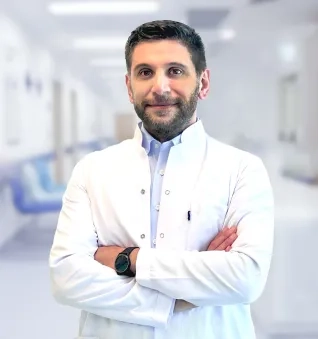Alo Yeditepe
Alo Yeditepe
Which Methods Increase Success in Treatment of Infertility?
In addition to the scientific approach adopted at In Vitro Fertilization Center of Yeditepe University, following methods are used to achieve healthy pregnancies and allow birth of healthy newborn infants.
Assisted Hatching
The term is defined as thinning or opening a certain part of the membrane that surrounds embryos (the zona pellucida) mechanically or using acidified Tyrode’s solution or laser. This technique aims to facilitate implantation of embryos into the uterine wall (endometrium).
Embryos need to implant into endometrium to ensure pregnancy along with nourishment and development of embryos (fertilized egg). If the membrane that surrounds the embryo is unusually thick, pregnancy may fail, as embryo may not implant into the uterine wall. The membrane is thinned or a very small hole is created in a certain part of the membrane through various methods to prevent this adverse event and facilitate implantation of embryo.
Although various chemical substances and enzymes were used in the past, laser systems are recently utilized for this procedure. Laser is used in women at or older than 35 who failed pregnancy in past in vitro fertilization attempts. Moreover, it is considered for embryos that will be biopsied for genetic diagnosis, embryos that are frozen and thawed and for women with failure of pregnancy in previous attempts despite high-quality embryo as well as women with high or borderline FSH.
Endometrial co-culture
Endometrial co-culture is a new hope for couples, who cannot achieve pregnancy despite multiple ART (assisted reproductive techniques) attempts or have poorly or slowly growing embryos. A tiny tissue piece is biopsied from endometrium on Day 21 of the period and an artificial endometrial tissue is obtained by growing the biopsy specimen at laboratory settings. Embryos are implanted into this tissue. Since native endometrial cells of the women are used for this practice, risky conditions are eliminated, such as jaundice, AIDS and others. Endometrial cells are not hazardous for development of embryo and even, they increase chance of growth by maintaining the development.
Blastocyst culture
Blastocyst is the term that refers to embryo on day five of fertilization. In assisted reproductive technologies, generally acknowledged practice is to transfer embryos three days after fertilization. Transfer of embryos in blastocyst phase yields certain significant gains. For example, embryos that can survive until this phase are more likely to implant. These embryos have higher capability of survival until day five relative to other embryos.
Pre-implantation Genetic Diagnosis
Numerous hereditary diseases can be diagnosed even at embryonic phase. This technique, called Preimplantation Genetic Diagnosis (PGD), allows selection of only healthy embryos that will be transferred into the uterus. In this method, 1 or 2 blastomer cells are biopsied from each embryo and the genetic locus that is responsible for the disease is amplified through single-cell PCR, when embryos with normal development reach 7- to 8-cell stage following the fertilization.
Embryo Freezing
Embryos are frozen due to absolute indications that are linked to female factors. For example, all embryos are frozen, when a certain condition, such as ovarian hyperstimulation syndrome, occurs during hormone therapy at the phase of embryo transfer. Posing a life threatening risk for the woman, this clinical picture should be regressed and embryo should be thawed and transferred in a safer time. However, embryos can also be frozen and stored, if the thickness of innermost lining of the uterus (endometrium) is not suitable for pregnancy, and embryos are transferred when intrauterine cavity is better prepared.
Removal of Fallopian Tubes
Hydrosalpinx implies total block of Fallopian tubes at the ovarian end and the condition is a major barrier against pregnancy. The condition that affects implantation of embryo adversely can be diagnosed with ultrasound and it is among most critical and common problems that decrease chance of in vitro fertilization. Accumulating in lumen of Fallopian tubes, the fluid flows into uterine cavity and thus, embryos cannot implant or pregnancy results in miscarriage in early phases. After intrauterine cavity is imaged to determine severity of hydrosalpinx more clearly, a laparoscopic surgery can eliminate this problem. In this case, laparoscopic removal of tubes or ligation of tubes at the junction of the tube and the uterine cavity increases the success rate significantly.
Micro-dissection TESE
Micro-TESE is a surgical method that is used for treatment of severe male infertility. In case of azospermia that is not associated with blockage of reproductive channels, Micro-TESE is considered to harvest sperm under microscope. Sperms can actually be obtained in twenty percent of cases without obstruction in reproductive channels in conventional testicular biopsy (TESE), while the figure is 45 percent for micro-TESE.
Opening new horizons for couples who plan pregnancy, micro-TESE is an outpatient procedure that is performed under local or general anesthesia and it lasts for 1 to 4 hours depending on complexity of the case. If the procedure is carried out under local anesthesia, patients can very soon engage in daily routines. In case of general anesthesia patients are mobilized within 1 to 2 hours and they can return to activities of daily life in several days.
This content was prepared by Yeditepe University Hospitals Medical Editorial Board.
”
See Also
- What is Whooping Cough? The Importance of Whooping Cough Vaccination During Pregnancy
- Contraceptive Methods: Birth Control and Effective Protection Options
- What is Ovarian Reserve?
- Uterine Polyps, Symptoms and Treatment
- Genetic Diagnosis in IVF Treatment
- What Happens at 3rd Weeks of Pregnancy?
- What Happens at 2nd Week of Pregnancy?
- What is Endometriosis? What are the Symptoms of Endometriosis?
- What is Hormone Replacement Therapy (HRT)? How is HRT Performed?
- Hormonal Disorder Symptoms and Treatment
- What is Ureaplasma? How is Ureaplasma Treatment Done?
- What is Pelvic Floor? What are Their Duties?
- The Most Common Diseases in Women
- What is Hysteroscopy? Hysteroscopy Usage Areas
- What is Myoma? Myoma Symptoms and Treatment
- Early Menopause and Ovarian Failure Can Be Prevented
- What is Laparoscopic Surgery in Gynecology?
- Menopause Symptoms and Menopause Treatment
- Polycystic Ovary Syndrome and its Treatment
- Electromagnetic Stimulation in the Treatment of Endometriosis and Infertility
- How Does Working Life Affect Prospective Mothers?
- Causes of Female Infertility
- The Use of Non-Inpatient Closed Surgery is Increasing in Gynecological Diseases
- Chronic Pelvic Pain
- What is Polycystic Ovary Syndrome/PCOS?
- Postpartum Period
- 7 Effective Tips Against Urinary Incontinence
- What is Menopause? When Does Menopause Age Begin? What are the Symptoms of Menopause?
- The Chance of Becoming a Father Increases with Microchip Technology
- Thanks to the Ovarian Rejuvenation Method, She Counts the Days for Birth!
- Tests That Need to Be Performed During Pregnancy
- Which Tests Should Expectant Mothers Not Neglect? What Tests Should Be Done While Pregnant?
- Some Patients Go Through Menopause Even at the Age of 15
- Stress Disrupts the Menstrual Cycle
- Myomas Can Grow During Pregnancy
- Useful Bacteria Increases IVF Success
- Polycystic Ovary Syndrome Can Occur If the Bacteria in the Gut Are Not Functioning Well
- Imaging Methods During Pregnancy
- After 16 Years, She Wanted to Be a Mother Again; She Experienced the Shock of Her Life
- These Diseases Affect Women Differently Than Men
- Beware of Chocolate Cyst! It Affects 1 in 10 Women
- Causes of Male Factor Infertility
- The Effect of Advanced Age on IVF Treatment
- Infertility
- Polycystic Ovary Syndrome
- Early Menopause
- Blocked Fallopian Tube
- Vaginismus
- Low Ovarian Reserve (AMH)
- Intrauterine insemination (IUI)
- Microinjection
- Egg Cryopreservation
- Assisted Hatching
- Micro-chip
- Pre-implantation Genetic Diagnosis
- Thyroid Diseases During Pregnancy Affect the Baby as Much as the Mother
- Urinary Tract Infections Can Be A Sign Of Menopause
- 10 Overlooked Signs of Menopause
- Endometriosis
- Co-Culture
- Ovarian Rejuvenation / PRP
- As Average Life Expectancy Increases, This Problem Will Be Seen More
- 'Early Age' Warning for Egg Freezing Procedure
- Beware, These Risks Increase After Menopause!
- This Problem Ruins the Lives of One in Every 10 Women
- Getting Cancer Treatment Does Not Stop You from Having Children!
- Prof. Dr. Attar: Endometriosis Can Be Associated With Some Chronic Diseases
- What Is the Period of Fertility? What Tests are Performed for Fertility?
- What Happens at 38 Weeks of Pregnancy?
- What Happens at 37 Weeks of Pregnancy?
- What Happens at 36 Weeks of Pregnancy?
- What Happens at 35 Weeks of Pregnancy?
- What Happens at 34 Weeks of Pregnancy?
- What Happens at 33 Weeks of Pregnancy?
- What Happens at 32 Weeks of Pregnancy?
- What Happens at 31 Weeks of Pregnancy?
- What Happens at 30 Weeks of Pregnancy?
- What Happens at 29 Weeks of Pregnancy?
- What Happens at 28 Weeks of Pregnancy?
- What Happens at 27 Weeks of Pregnancy?
- What Happens at 26 Weeks of Pregnancy?
- What Happens at 25 Weeks of Pregnancy?
- What Happens at 24 Weeks of Pregnancy?
- What Happens at 23 Weeks of Pregnancy?
- What Happens at 22 Weeks of Pregnancy?
- What Happens at 21 Weeks of Pregnancy?
- What Happens at 20 Weeks of Pregnancy?
- What Happens at 19 Weeks of Pregnancy?
- What Happens at 18 Weeks of Pregnancy?
- What Happens at 17 Weeks of Pregnancy?
- What Happens at 16 Weeks of Pregnancy?
- What Happens at 15 Weeks of Pregnancy?
- What Happens at 14 Weeks of Pregnancy?
- What Happens at 13 Weeks of Pregnancy?
- What Happens at 12 Weeks of Pregnancy?
- What Happens at 11 Weeks of Pregnancy?
- What Happens at 10 Weeks of Pregnancy?
- What Happens at 9 Weeks of Pregnancy?
- What Happens at 8 Weeks of Pregnancy?
- What Happens at 7 Weeks of Pregnancy?
- What Happens at 6 Weeks of Pregnancy?
- What Happens at 5 Weeks of Pregnancy?
- What Happens at 4 Weeks of Pregnancy?
- What Happens at 1st. Weeks of Pregnancy?
- Considerations for Embryo Transfer
- What Causes Menstrual Irregularity, How Is It Treated?
- Success in IVF after 43 Decreases to Five Percent
- Does Pregnant Coronaviruses Affect?
- Most Frequently Asked Questions During Pregnancy
- Untreated Genital Problems Can Cause Urinary Incontinence
- 1 in 10 Women Have This Problem; It Can Lead To Infertility
- Effective Results Can Be Achieved with PRP in Women with Low Egg Count
Alo Yeditepe









